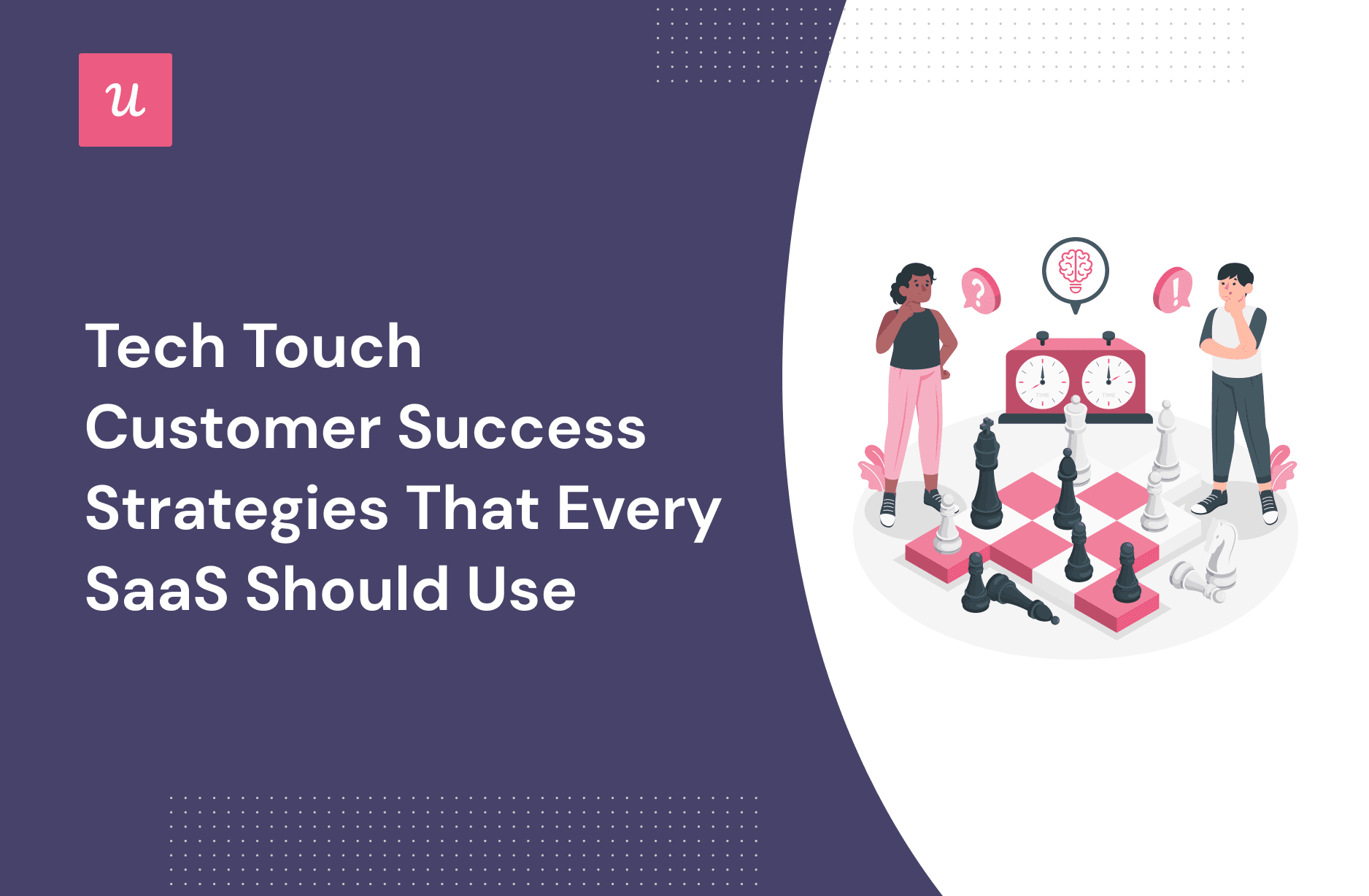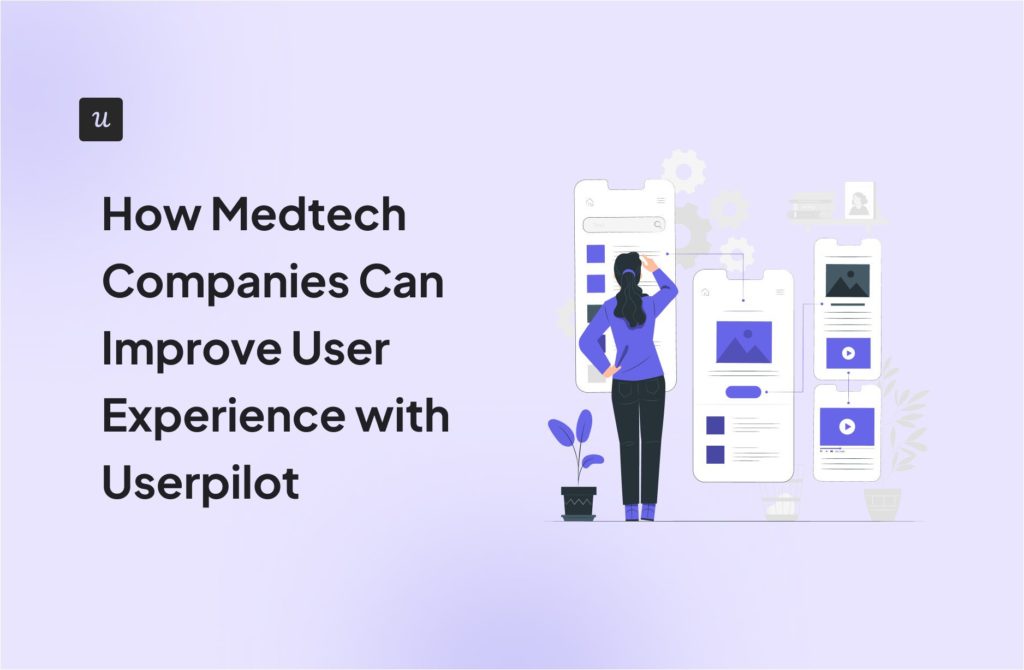
Tech Touch Customer Success Strategies That Every SaaS Should Use
Tech-touch customer success offers a highly-relevant and personalized experience to your customer while also being automated using software.
What’s better, any SaaS business can leverage tech-touch strategies to increase customer loyalty and scale customer success more efficiently.
So if you’re in, let’s clarify the concepts:
Get The Insights!
The fastest way to learn about Product Growth, Management & Trends.
What is tech-touch customer success?
Tech-touch customer success uses software to gather user data, analyze it, and personalize the product experience throughout the customer journey.
It’s more than low-touch onboarding that relies on software to onboard users.
It covers every stage of customer success beyond onboarding and every point of communication with the customer (in-app messaging, emails, chat, etc.). It also determines when human interaction is needed based on metrics like health score and net promoter score.
Tech-touch customer success vs. High-touch customer success vs. Low-touch customer success
Although tech-touch customer success sounds similar to low-touch onboarding, they are different engagement models.
Let’s clarify what each model means:
High-touch models
High-touch models are mainly used for complex products with enterprise customers who require constant interaction with a customer success manager to achieve success.
It always follows a 1-on-1 human onboarding experience.
So it can only scale well when the profit from the enterprise clients surpasses the cost of designating dedicated customer success managers.
Low-touch models
Low-touch models fit simple products with no complex features (thus don’t require much hand holding). It uses customer success resources and basic onboarding functions to make human interaction less needed.
The low-touch model is highly scalable but often implemented without personalization. Think one-size fits all product tours that just walk users through all the product’s features in one go.
Tech-touch models
Tech-touch models are different. They use automated communication like low-touch models but go beyond simple onboarding and standard automation.
- Tech-touch is 100% customer-centric. It uses data to hyper-personalize the customer experience.
- This model uses every form of communication, such as emails, chatbots, in-app messaging, and more.
- It engages the customer proactively across the entire user journey, from the initial sign-up to the activation point, feature adoptions, and account expansions.
- It’s different from the other models in terms of personalization and touchpoints where you automate engagement.
- Tech-touch also helps human-to-human interactions by automating the customer success managers’ tasks that don’t add value to the customers, such as sending personalized emails and answering common questions.
Why should customer success teams use a tech-touch strategy?
Unless your product is a simple online PDF converter tool (where you really don’t need onboarding) a tech-touch strategy is highly beneficial to:
- Scale your customer success and support service without expanding your team.
- Increase customer satisfaction, which leads to customer-led growth.
- Personalize the user experience with less effort and save your time.
Let’s go over the details:
Tech-touch strategies are highly scalable
Tech-touch strategies use automation software to handhold and engage users throughout their journey.
This model alone helps you scale your customer success service without having to hire multiple CSMs and deal with a flood of new accounts.
For a SaaS company, scaling your services is essential for healthy growth and long-term customer retention.
A tech-touch engagement model increases customer satisfaction
A tech-touch service is customer-centric, which means it:
- Listens to your customers.
- Understands what’s valuable for them.
- Uses insights from data to elevate the product experience.
You see, these qualities happen to be the main drivers of a customer-led growth strategy.

This means a successful tech-touch engagement results in more customer-led growth—which is driven by customer satisfaction and better customer relationships.
Hyper-personalization in less time
A tech-touch strategy needs to gather data to be successful, which means it can make customer success more efficient.
For example, your customer success team can monitor customer health scores to reach out to inactive users and use the data to help them (thanks to the software).

Also, you can easily personalize the product experience when owning data, showing highly contextual checklists or tooltips when the customer needs them.
Best practices for a successful tech-touch strategy
With a poorly implemented tech-touch model, you’re just automating a low-touch model with general functions and fixed paths.
For a proper tech-touch strategy to bring results, you need to:
- Work beyond onboarding. Cover the entire customer journey without limiting yourself to a few stages.
- Embrace omnichannel. Communicate and continue customer conversations across every channel.
- Go the extra mile with personalization. Use data and advanced segmentation to hyper-personalize the customer experience based on individual needs, JTBD, goals, and more.
- Diversify your data. Never stop gathering feedback from surveys, in-app behavioral data, forms, interviews, etc.
And you can only get started by segmenting your users based on different attributes.

But, how do you implement tech-touch strategies that follow these best practices?
6 Tech-touch strategies you should implement in SaaS to drive success
As said earlier, tech-touch experiences need to be hyper-personalized, never-ending, and omnichannel.
But what does that mean in practice?
Here are six tech-touch strategies for any SaaS company:
1. Use a tech-touch approach and personalize onboarding
Automating the onboarding process is not about adding one in-app flow or two—you must consider the whole onboarding experience.
Remember: the tech-touch approach works across all stages and channels.
So, rather than onboarding users with product tours and static guides, use progressive onboarding flows that rely on data to personalize the experience at every touchpoint.
For example, checklists are a great way to drive users to the activation point, just like this one:

But, you don’t have to limit yourself to a single checklist for driving activation.
You can also use checklists for secondary feature adoption or aid the checklist with other UI patterns to increase activation rates, such as:
- Personalized signup flows.
- Welcome pages.
- Contextual in-app guides and tooltips (that trigger when the user needs them).
2. Automate customer data collection with feedback surveys
Interviews, campaigns, or forms are still helpful for collecting data. But for a tech-touch strategy, you must find a way to automate data collection.
For example, you can collect customer satisfaction surveys at every stage of the journey (e.g., after the user engages with a feature for the first time). Then track how each stage performs, and spot opportunities for improvement.
A smart way to gather feedback is by adding a little icon in your UIs to allow users to submit feedback on specific features. Like this example from Miro:

Another way to collect data is by constantly sending NPS surveys to analyze what’s driving loyalty or causing dissatisfaction.
With this data, you can segment users with NPS tags and send personalized emails to NPS detractors to prevent them from churning:

In this example, we’re setting up a flow to reach out to NPS detractors with the tag “missing feature.”

Thanks to the NPS tags, you can send a message that targets their pain point and have better chances of preventing churn.
3. Offer proactive customer self-service support
You can’t be there for any customer around the globe, but you can add an in-app help center to give customers access to the knowledge base, tutorials, videos, and support tickets without leaving the product.
However, how is self-service support considered a tech-touch strategy if you show the same information to all users?
It’s not. It only becomes a tech-touch strategy when you trigger personalized resources based on the user’s segment and other conditions, just like this:

This is what proactive support is, and the goal is to ensure that the user has access to the information it needs without browsing through a flooded help center.
4. Drive repeated value to existing customers
A powerful advantage of the tech-touch model is that it can educate users at a granular level.
So instead of showing tedious product tours that the user will probably skip, you can continuously present one feature at a time when the user needs it.
For example, this feature adoption checklist guides the user to add partners for collaboration:

But, this feature is only relevant for users who are already activated, so it makes sense to use it on a corresponding user segment (those who can find this feature useful plus are already activated).
Plus, it becomes part of a larger flow of small UI patterns that lead the customer to success.
5. Keep customers in the loop with release notes and feature announcements
Constant communication is required to keep customers engaged.
But, you don’t want to annoy users with a large modal when a small tooltip would do the job.
That’s why a tech-touch model should communicate with the user in a less disrupting way.
For example, big release notes and major feature announcements are best communicated with a modal to ensure that most customers are aware of impactful changes.
Then, once the users have either engage or dismiss it, use different flows like tooltips or driven actions to point out changes.
But when it comes to optional functionalities or minor improvements, the user is better off with little hints and banners in the UI.
Think of how Slack uses tooltips to show new features without invading the whole screen:

6. Re-engage inactive customers and reduce churn
Sometimes users become inactive for unknown reasons, which makes in-app messaging less helpful.
For this reason, tech-touch models communicate with customers on any channel—especially when they’re not active.
However (for SaaS products), an inactive user isn’t simply someone who hasn’t logged in for a week. There must be multiple elements there.

You can also categorize a user as “inactive” when they don’t use the key features of your product (E.G., navigating through a social media scheduling app and not scheduling any content).
So, it’s better to identify inactive users by tracking product usage rather than general in-app “activity” disguised as “wandering around.”
Once you can identify inactive users automatically, you can send re-engagement email campaigns to reduce churn rates, such as:
- Reminding users to follow an onboarding step they missed.
- Triggering urgency with limited offers.
- Asking for feedback from unhappy users.
- Presenting a missing feature that’s now available (and is relevant for their use case).
- Sharing content that could motivate them to use the product again.
For example, check this win-back email from Eversign. Notice that it encourages the reader to visit the help center in case it went inactive due to basic support issues.

Conclusion
Tech-touch customer success is a lever for SaaS growth.
For any B2B software, you can use this model to engage customers throughout their journey and scale your business with less operating costs.
But, the only way to implement these tech-touch strategies without hard coding is with a user engagement tool like Userpilot.
So if you want to build UI patterns and send regular NPS surveys in a breeze, get a Userpilot demo and see how you can engage your new customers.






